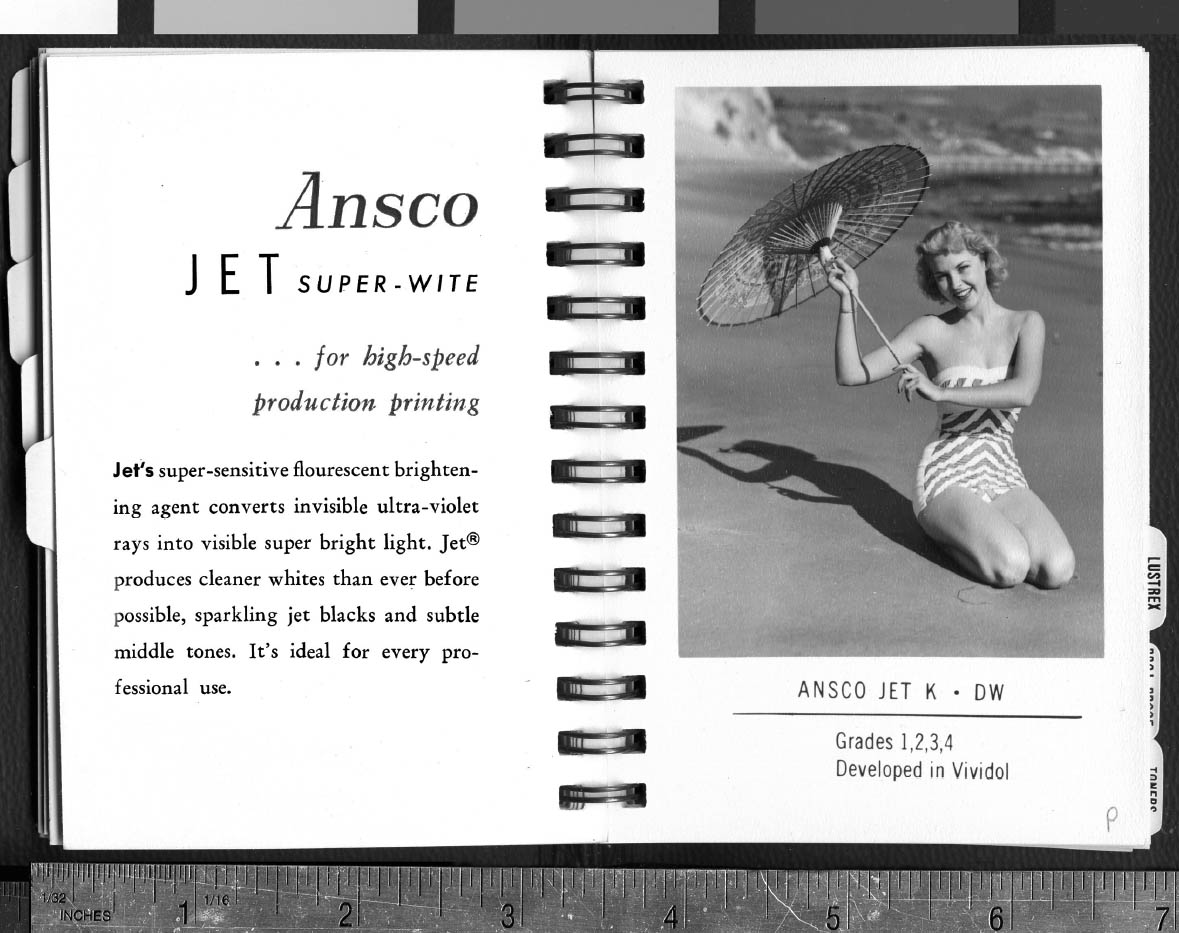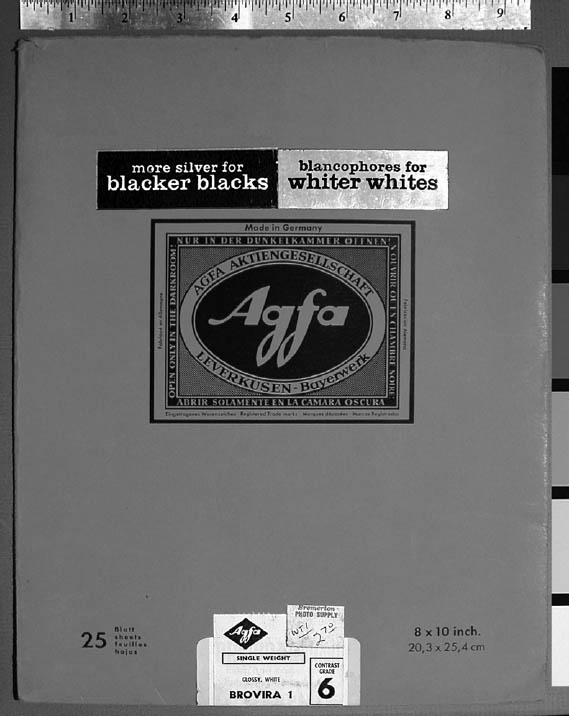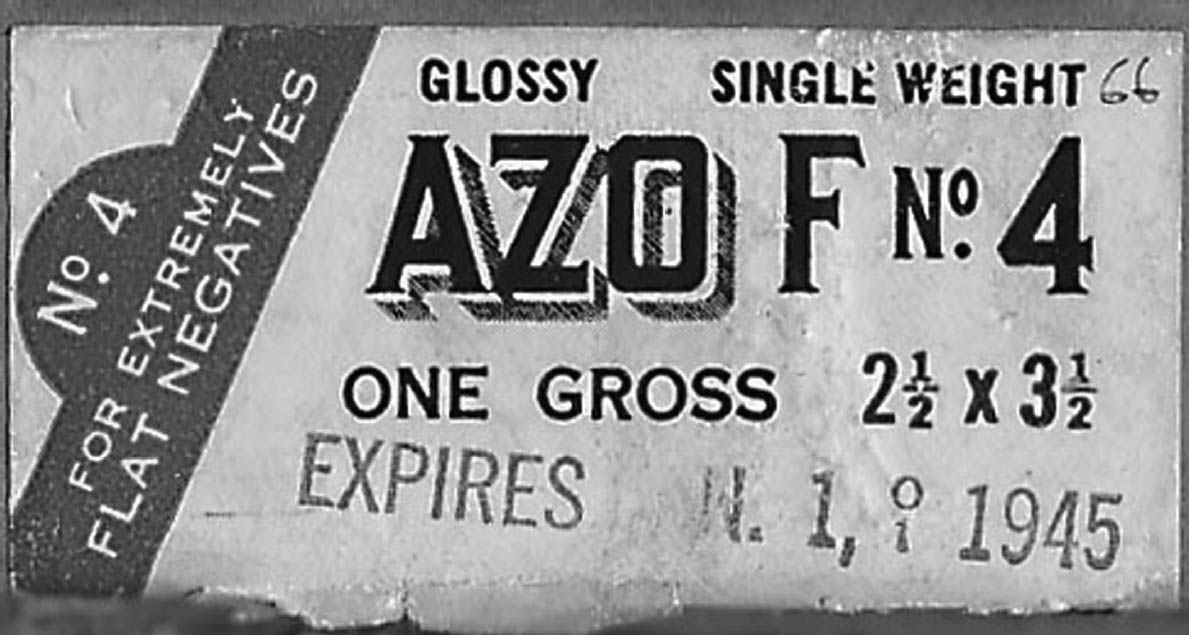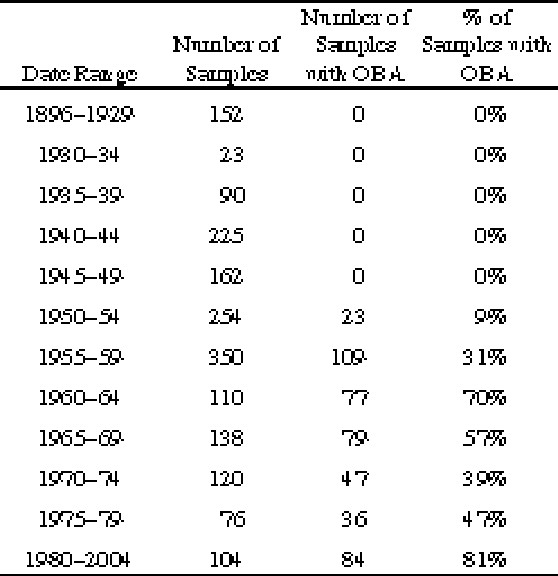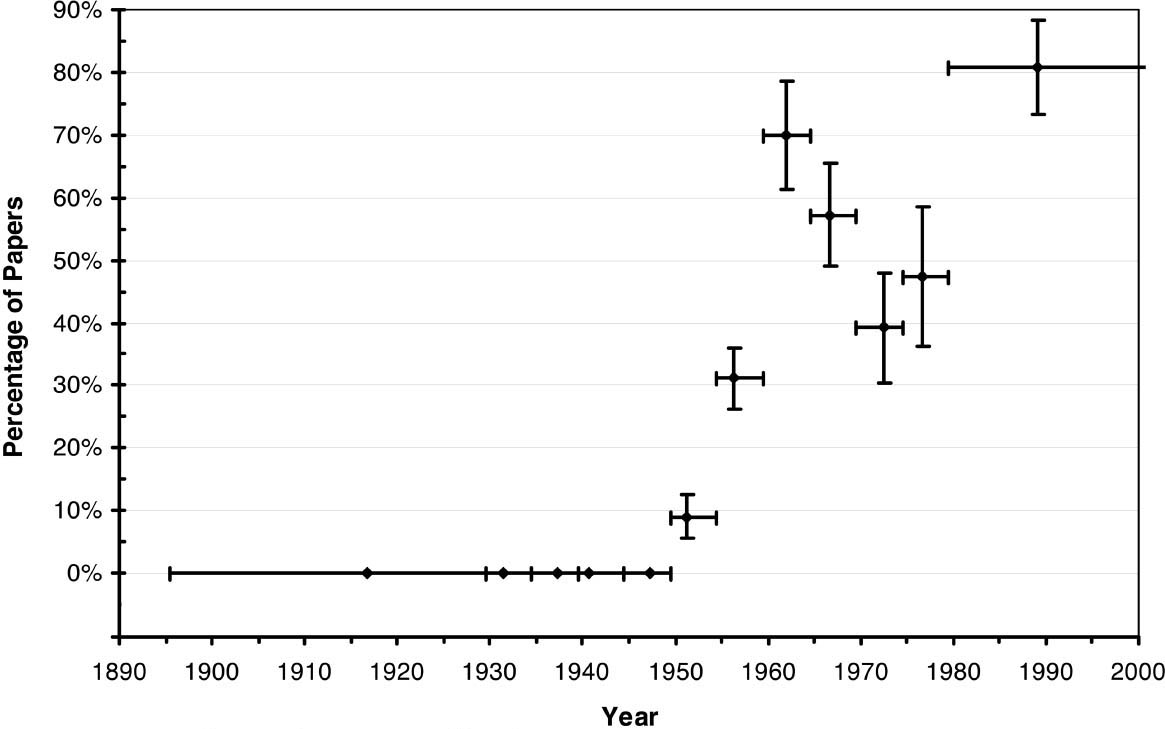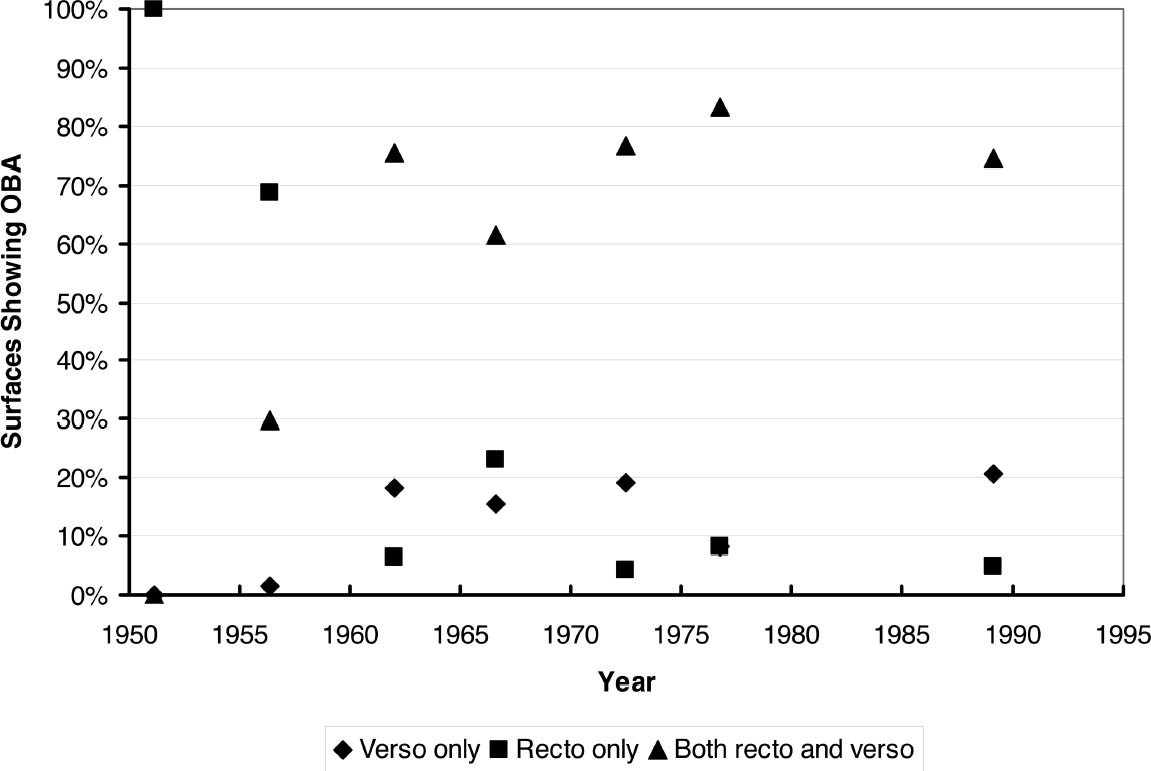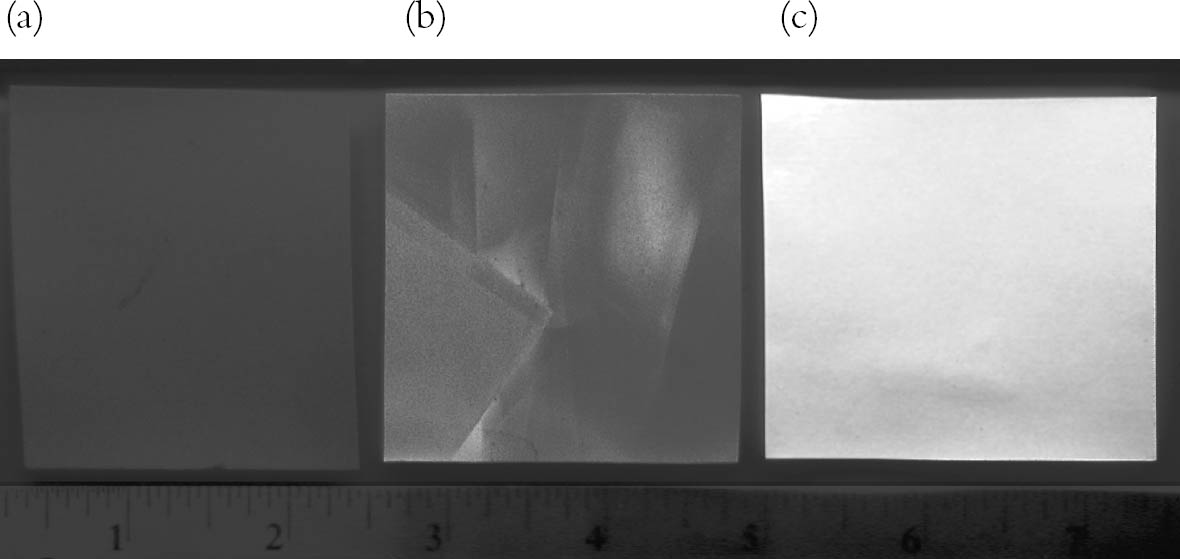OPTICAL BRIGHTENING AGENTS IN PHOTOGRAPHIC PAPERPaul Messier, Valerie Baas, Diane Tafilowski, & Lauren Varga
ABSTRACT—A reference collection of mostly 20th-century photographic paper was surveyed for the presence of optical brightening agents. Only fiber-based, gelatin silver paper was assessed. In all, 1,804 samples were examined, dating from 1896 to 2004 and representing 40 different manufacturers. No optical brightening agents were found in samples dating from 1896 to 1949. The first occurrence of optical brightening agent was found in samples dating between 1950 and 1954. Between 1955 and 1964, the frequency of occurrence for optical brightening agents increased rapidly. Toward the latter part of this date range the occurrence of optical brighteners rose, with 70% of all samples showing brighteners. Between 1965 and 1979, occurrence of optical brightening agents declined to a low of 39% of all samples. A marked increase in occurrence was observed after 1980, when 81% of samples exhibited optical brightening agents. These results indicate that a significant proportion, and for some time periods a significant majority, of black-and-white, paper-based photographs made after the early 1950s contain optical brightening agents. This finding has implications for the treatment and display of photographs, as the presence of optical brightening agents is not routinely documented and the effects of storage environment, display, and treatment are poorly understood. TITRE—Les azurants optiques dans les papiers photographiques. R�SUM�—Une collection de r�f�rence compos�e en grande partie de papiers photographiques fabriqu�s au 20�me si�cle a �t� examin�e pour d�tecter la pr�sence d'azurants optiques. Seuls les papiers g�latino-argentiques baryt�s ont �t� �valu�s. En tout, 1,804 �chantillons ont �t� examin�s, datant de 1896 � 2004 et repr�sentant 40 fabricants diff�rents. Aucun azurant optique n'a �t� d�tect� dans les �chantillons datant de 1896 � 1949. Les premi�res traces d'azurants optiques ont �t� retrouv�es dans des �chantillons datant de 1955. Entre 1955 et 1964, la fr�quence de leur usage a augment� rapidement et vers la derni�re partie de cette p�riode, on en a retrouv� dans 70% des �chantillons. Entre 1965 et 1979, leur pr�sence a seulement �t� d�tect�e dans approximativement 39% de tous les �chantillons. On a observ� ensuite une augmentation marqu�e apr�s 1980, quand approximativement 81% des �chantillons contenaient des azurants optiques. Ces r�sultats indiquent qu'une proportion importante, et pendant certaines p�riodes une majorit� signifiante, de photographies argentiques noires et blanches sur papier baryt� tir�es apr�s 1955 contient des azurants optiques. Cette constatation a des implications pour le traitement et l'exposition des photographies car la pr�sence d'azurants optiques est rarement not�e et on comprend encore peu les effets caus�s par l'environnement, l'exposition � la lumi�re et les traitements. T�TULO—Agentes de Clareamento �ptico em Papel Fotogr�fico. RESUMO:—Uma cole��o de refer�ncia, na maioria de pap�is fotogr�ficos do s�culo XX, foi examinada para se detectar a presen�a de agentes de clareamento �ptico. Apenas papel de fibra ‘a base de gelatina de prata foi examinado. Ao todo, 1,804 amostras, datando de 1896 a 2004 e representando 40 fabricantes diferentes foram examinadas. N�o foram encontrados agentes de clareamento �ptico nas amostras datando de 1896 a 1949. A primeira ocorr�ncia de agentes de clareamento �ptico foi encontrada em amostras datando de 1955. Entre 1955 e 1964, a freq��ncia da ocorr�ncia de agentes de clareamento �ptico cresceu rapidamente. Mais pr�ximo da data limite dessa amostragem, a ocorr�ncia de clareadoes �pticos aumentou, com aproximadamente 70% de todas as amostras revelando clareadoes. Entre 1965 e 1979, a ocorr�ncia de agentes de clareamento �ptico decaiu para aproximadamente 39% de todas as amostras. Um aumento consider�vel na ocorr�ncia foi observado depois de 1980, quando aproximadamente 81% das amostras exibiram agentes de clareamento �ptico. Esses resultados indicam que uma propor��o significativa – e, para alguns per�odos de tempo, uma significante maioria – de fotografias em preto e branco em papel feitas depois de meados dos anos 50, cont�m agentes de clareamento �ptico. Essa descoberta tem implica��es no tratamento e em exposi��es de fotografias, uma vez que a presen�a de agentes de clareamento �ptico n�o � rotineiramente documentada e os efeitos do meio-ambiente dos locais de armazenagem, exposi��o e tratamento s�o parcamente compreendidos. TITULO—Agentes abrillantadores �pticos en papel fotogr�fico. RESUMEN—Se llevo a cabo un diagn�stico para detectar la presencia de abrillantadores �pticos en una colecci�n de referencia de papeles fotogr�ficos, la mayoria del siglo XX. Unicamente el papel de gelatina de plata y con contenido de fibra fue examinado. En total se examinaron 1.804 muestras fabricadas entre 1896 y el 2004 y que representan a 40 fabricantes. No se encontraron abrillantadores �pticos en las muestras de 1896 a 1949. La muestras mas tempranas que contiene abrillantador �ptico son de 1955. Entre 1955 y 1964 el n�mero de muestras en las que se encuentran abrillantadores �pticos aumenta rapidamente. En los ultimos a�os de este per�odo aument� el n�mero de muestras con abrillantador �ptico hasta un 70%. Entre 1965 y 1979, el n�mero de muestras con abrillantador �ptico disminuy� hasta un 39% de todas las muestras. Despues de 1980 se observ� un aumento marcado de la presencia de abrillantadores �pticos hasta en un 81% de las muestras. Los resultados indican que una proporci�n significativa y en algunos periodos una mayoria importante de fotografias en papel, en blanco y negro hechas despues de 1955 contienen abrillantadores �pticos. Esto tiene implicaciones en el tratamiento y la exhibici�n de fotografias, ya que la presencia de abrillantadores �pticos no es documentada siempre y los efectos del medio ambiente del almacenamiento, la exhibici�n y el tratamiento a�n no se entienden a cabalidad. 1 INTRODUCTIONFor the past several years, the use of optical brightening agents in photographic papers has increasingly attracted the attention of conservators, curators, art dealers, and collectors. For the most part, this recent notice stems from the use of optical brightening agents for dating photographs. When present, optical brightening agents are usually easy to detect, as the compounds produce a distinct cool, blue-white fluorescence when exposed to near-ultraviolet radiation. Based on papermaking literature, sources within the photography industry, and the examination of reference collections of known provenance, the start date for the incorporation of optical brightening agents in photographic papers is generally held to be the mid-1950s. Within the last several years two major authenticity scandals, involving images by Man Ray (1890–1976) and Lewis Hine (1874–1940), were sparked when prints that purportedly dated from the 1920s and 1930s were found to incorporate optical brightening agents and other materials-based anachronisms (Falkenstein 2000; Woodward 2003). Indications pointing to the mid-1950s as the industry start date for the incorporation of optical brighteners are strong though largely undocumented. Persons associated with the photographic industry have consistently maintained that the use of brighteners began in the 1950s and increased rapidly throughout the 1960s. This same period is also cited for the introduction of optical brighteners for the wider papermaking industry (Browning 1977). While research into fluorescent additives dates from the late 1920s, there is evidence to suggest that it was not until the introduction of dyes based on the compound stilbene, in the early 1940s, that a method for industrial-scale fluorescent brightening of paper and textiles seemed practical (Mustalish 2000). For example, present and former Kodak staff members independently cite an internal report from February 1951 that proposed the use of optical brightening agents and estimate that the earliest commercial application of brighteners did not occur until the mid-1950s (Warner 1999;Valvo 1999). This report by the Paper Service Division at Kodak describes a survey under way as early as 1949 in which papers treated with a fluorescent dye identified as “Pontamine White BR” were compared by “professional and amateur examiners” to determine preferences (Kodak Paper Service Division 1951). The primary finding of the survey is that the general preference among those surveyed was for nonbrightened paper. For this reason, the report concludes, “The use of fluorescent dyes for the brightening of this type of photographic paper is therefore not recommended” (p. 2). While this document helps date an industry leader's interest in brighteners, left unclear is when Kodak disregarded the recommendation in the report and began using brighteners. Proprietary and otherwise confidential reports documenting the analysis of prints attributed to Man Ray and Lewis Hine by Agfa materials research staff indicate the company began using brighteners in its papers during the late 1950s. Independent of this work, other staff at Agfa also point to the late 1950s as the starting point for the use of optical brightening agents (Auer 1999). This manufacturer information is supported by occasional According to Kodak staff, while brighteners can be integrated into paper raw stock, emulsions, baryta, and processing chemicals, the more recent trend is to apply brighteners as a surface coating, which is more effective and economical (Gray 1999). This same source indicates that brighteners added to pulp, in the wet end of a Foudrinier machine, can result in a speckled fluorescence of the paper base (observed with near-ultraviolet radiation), as different fibers in the pulp have variable degrees of dye absorption. An industry source from Ciba Specialty Chemical Corporation stated that while there are presently many specialized uses for optical brightening agents and while many different companies all over the world manufacture these compounds, brighteners are still mostly based on the stilbene molecule (Cheek 1999). Though this evidence carries significant weight, there is still no definitive primary source indicating when the photographic industry began incorporating optical brightening agents (Mustalish 2000). The purpose of this study was to test and supplement this existing body of evidence by developing an authoritative baseline documenting the use of optical brightening agents in 20th-century photographic papers. 2 MATERIALS AND METHODS2.1 SAMPLE PREPARATIONSamples for this study come from a variety of sources but were mostly acquired from Internet auction sites starting in 1999. The samples fall into two broad categories: books of specimen prints and packages of unexposed photographic paper. Seventy-seven books of specimen prints were examined, contributing a total of 1,159 samples to the overall total. The earliest book of specimen prints dates from 1910. Books of specimen prints are an almost ideal source for this type of research, since they are usually dated and often provide a comprehensive inventory of a manufacturer's papers for a given year (fig. 1). In addition, they require no advance preparation for this type of an experiment. One drawback, however, is that some papers in books are mounted to a secondary support, making evaluation of the reverse of a sample difficult or impossible. The other main source of samples was original packages of unexposed photographic paper (fig. 2). The packages were opened in a photographic darkroom under safe light. A single sheet of paper was removed from the package. Two samples were cut from the sheet, each measuring 2 � 2 in. (5.08 � 5.08 cm). Any remaining sheet was returned to the package. Packages were resealed for storage in lighttight polypropylene bags. Samples were labeled with a catalog number in pencil on the reverse. They were fixed using ammonium thiosulfate, washed in water for 25 minutes, and air-dried. While requiring significantly more preparation than the books, papers removed from original packages were in some ways better suited for this study since they could always be assessed on both the recto and the verso. Papers taken from original packages contributed 645 samples to the study. The earliest paper had a manufacturer-applied expiration date of 1896. Only fiber-based, gelatin silver papers were assessed. Each sample was unique in that samples with duplicate brand, finish, emulsion, and date were eliminated from the survey. The paper samples come from a total of 40 manufacturers. Most of the historically prominent American and European manufacturers were represented, including Agfa, Agfa-Gevaert, American Aristotype, Ansco, Beseler, Boots, Cachet, Darko, Dassonville, Defender, Dupont, Forte, Gavaert, Guilleminot, Haloid, Ilford, Kilborn, Kodak, Luminos, Oriental, 3M, and Xerox, among others. The samples cover 264 different brand names and even more surface finishes, emulsion speeds, and base paper colors. 2.2 SAMPLE DATING AND IDENTIFICATIONEach of the samples in this study was identified by manufacturer, brand, and paper finish. This information was taken from specimen book labels or from the packaging of unexposed paper. Each sample was also dated. For specimen books, the dates were taken from the copyright date of the book, usually present inside While every paper in the study was dated according the methodology outlined above, some uncertainty remains when it comes to establishing an absolute chronology of the samples included in the study. The first is that the copyright date of a specimen book and the expiration date of a package of paper do not convey the same information. More important, the relationship between these dates and the actual manufacture date of a paper also requires some interpretation. Results from this study and any subsequent study based on similar reference collections of photographic paper will need to account for the differences between publication dates and expiration dates and for the relationship of these dates to actual manufacture dates.
For the purposes of this study, the publication date of a specimen book is assumed to be very close to the actual manufacture date of the papers presented in the book. Based on an examination of the sample books in the collection, it appears that most manufacturers produced these books annually, presenting updates and innovations in their line of papers. Nevertheless, it is possible that older papers could be included in a book if the older paper was still considered to be reasonably representative of current stock by the manufacturer. Expiration dates from packaged paper present a similar situation as these dates will always be after the actual manufacture date. While there has never been an industry standard, a two-year interval between manufacture date and expiration date would be reasonable for most papers, though intervals up to four and possibly five years appear possible. To provide some objective grounding for this observation, a comparison was made between the copyright date on processing instructions and expiration dates of the paper found in the same package. Eighty samples in the collection were found that contained both an expiration date and dated processing instructions within the same package. The 80 samples had a wide range of expiration dates, from 1911 to 1989. This procedure revealed that the average interval between the copyright date on the processing instructions (placed inside the package) and the expiration date (labeled outside the package) was 2.8 years.
There are indications that manufacturers used a wide variety of variables when determining the expiration dates of papers. The most significant factor in determining expiration dates was the speed of the emulsion. Faster emulsions for enlarging (silver bromide) papers were thought to “expire” more readily than slower emulsions (silver chloride and chlorobromide) that were more suitable for contact printing. Manufacturers realized that environmental conditions of temperature and humidity were by far the most significant variables affecting the keeping property of photographic paper and that these variables were largely beyond the control of the manufacturers. While better moisture-proof packaging and various proprietary chemical stabilizers were developed by manufacturers, there was a general consensus in the industry that expiration dates had fairly limited value in predicting whether a certain paper would behave according to specifications. Given the somewhat imperfect usefulness, Ansco Corporation deliberated over a period of years whether to drop expiration date labels (Krause 2003). Fortunately for this study, however, most manufacturers generally persisted in applying expiration date labels despite the limitations. Regrettably, a large proportion of papers gathered for this work from the Agfa Corporation were undated and therefore omitted from the sample group. To summarize the sample dating methodology: The dates used in this study are the copyright dates of specimen books and expiration dates of packaged papers. For most samples, specimen book dates are thought to be within a year of actual paper manufacture. Expiration dates are thought to postdate manufacture by approximately two years, though these may postdate manufacture by as little as one year and as much as four to five years for a small percentage of samples. Since publication dates and expiration dates are absolute, concrete values, and since no adjustment factor of these values would be entirely reliable, no attempt was made to normalize these values for this study. However, adjusting these dates to more accurately reflect manufacture date may be justified for future work using this or other reference collections. 2.3 DETECTION METHODSamples were examined visually in a darkened room using long-wave ultraviolet (UV) radiation in the range of 320 to 380 nm. The UV source was a handheld, 20W, 24 in. fluorescent tube “black light” manufactured by the General Electric Corporation. Most common optical brighteners have peak absorption in a range around 375 nm, with emission of a bluish white light peaking at approximately 450 nm (Mustalish 2000). Samples emitting this distinct fluorescent “glow” were tabulated. Samples were examined on both recto (emulsion side) and verso (paper base). As mentioned, some samples in specimen books were mounted overall to secondary supports, making a determination of fluorescence behavior of the verso impossible. In most cases, the subjective determination of whether brighteners were present was very clear-cut, as illustrated in section 4. However, the natural fluorescence of the gelatin and of the paper sizing and the reflection of blue light emitted by the UV source complicated matters when low levels of brighteners were present. Borderline cases were reexamined and usually resampled by the authors until a consensus opinion could be formed. Samples with indistinct fluorescence possibly attributed to optical brightening agents amounted to no more than 10 or 12 samples (less than 0.6% of the entire sample group). 3 RESULTS3.1 OBSERVATIONSResults for individual papers were grouped by date. Grouping the data over a span of five or more years was considered necessary to account for the inability to assign absolutely precise manufacture dates as described in section 2.2. Table 1 presents the groupings, date ranges, number of samples assessed, and number and percentage of samples showing optical brightening agents. Figure 4 presents a plot of these data. 3.2 ANALYSIS AND INTERPRETATIONAs stated in section 2, the photographic papers used for this study were purchased almost entirely from Internet auction sites. This collecting method relies exclusively on chance availability of one or two lots at a time coming from individual sellers located
Assuming a valid random sampling and allowing for some statistical uncertainty, the results of the survey can reasonably be applied to the population of papers produced over the last 100 years. The number of samples assessed dictates the level of statistical uncertainty. In addition to presenting the data in table 1, most points in figure 4 have a Y-axis error bar that shows how data from this study represent the entire population of papers at a 95% confidence interval. The confidence intervals were determined by the
where efficiency e is the number between 0 and 1 measuring the probability of a sample randomly selected inside the given time interval containing optical brightening agents, n_OBA is the number of samples with optical brightening agents, and n_total is the total number of samples in the specified time interval, and
where sigma_e is the statistical error on the efficiency (or the error resulting from the fact that not all papers produced in a given year were sampled). X-axis bars at each point show the date range covered for each group of samples. Within each date range, the diamond-shaped data points are placed at the average date for the samples. As shown in table 1 and figure 4, no optical brightening agents were found in the 652 samples dating from 1895 to 1949. The earliest finding of optical brightening agent was in the period 1950 to 1954. In this early period, 9% of samples showed optical brightening agents. The percentage of papers with optical brightening agents increased rapidly after 1955, with a peak occurrence rate of 70% between 1960 and 1964. Occurrences of optical brightening agents declined in the period between 1965 and 1979 to a low point of 39%, then increased after 1980 to 81%. As stated in section 2.3, whenever possible, samples were examined on both the recto (emulsion) and verso (paper base) for the presence of optical brightening agents. Figure 5 shows the distribution of occurrences based on surface(s) showing optical brightening agents. Only papers where both recto and verso were accessible (eliminating mounted photographs) are included in the chart.
As shown in the figure 5, brighteners were found almost exclusively in the emulsion side between 1950 and 1960. After this early period, brighteners predominantly were found on both surfaces at levels ranging from 62% to 83% of all occurrences. 4 DISCUSSION AND CONCLUSIONSThe results of the survey provide an objective basis for the widely held observation that the use of optical brightening agents in photographic paper began in the early to mid-1950s and increased rapidly thereafter. The survey also gives some insight into the extent of brightener use by the various manufacturers over time, making a strong case that a very large proportion, and in some cases the majority, of fiber-based, gelatin silver papers contained optical brightening agents for certain periods during the 20th century. As the reference collection continues to grow, new additions to the collection will be checked for optical brighteners, and these data will be periodically added to the results presented in this study. This work highlights some important issues for the characterization of photographic papers. In particular, the method used to determine whether a paper contained optical brightening agents has limitations. While visual inspection in the dark with near-ultraviolet radiation is generally fine for detecting most occurrences of optical brighteners, there is a subjective component to this method that can be problematic in some cases. Many photographic papers appear “bright” observed with ultraviolet radiation but are not necessarily “brightened.” A bright appearance can be attributed to other factors besides optical brightening agents. For instance, gelatin has a natural fluorescence that can be enhanced through the use of certain dyes or other additives (Wentzel 1960). Baryta coatings also can be highly reflective of unfiltered blue light emitted by most sources of near-ultraviolet radiation. This blue reflection can sometimes be difficult to distinguish from the blue-white fluorescence emitted by optical brightening agents. These complicating factors are easily overcome when prints have a high concentration of functional optical brightening agents, as shown in figure 6. However, these and other variables can present a more significant problem if the brighteners are degraded or present in low concentrations. While it is extremely unlikely that these complications had a significant influence on the overall results presented in this study (as mentioned in sec. 2.3, samples with uncertain brightener content amounted to no more than 10 or 12 samples, or less than 0.6% of the entire sample group), experience examining historic photographs that have been displayed (unlike the samples used in this study) or stored under adverse conditions
The research also indicated that brighteners, at least for some samples, are water-soluble. Many samples prepared early in the project were washed together. Upon inspection with ultraviolet radiation it became clear that some samples were picking up brighteners from immersion with other samples and/or from contact with wet samples. This observation has been made by others (Lav�drine 1995) and bears additional research. Water solubility of brighteners could affect conservation treatment practice, especially for wet treatments applied to optically brightened photographs or for treatments during which optically brightened and unbrightened photographs might be intermingled. For this project, contaminated and suspect samples were resampled, washed, and dried individually. As shown in figure 6, contaminated samples were generally easy to detect, as the brighteners were present in discrete patches or blurry spots and swirls. It is likely that more fiber-based, black-and-white papers made after the mid-1950s contain brighteners than are indicated by the results of this study. Processing chemistry, such as developers and postprocessing treatments, can also add brighteners to photographic paper. The availability and prevalence of such treatments over the past 50 years need closer examination. Due to the large proportion of 20th-century prints found to contain optical brightening agents and since there is a chance that wet treatment can affect brighteners, some changes in conventional conservation practice might be worth consideration. The first step in this process would be to document the presence of brightening agents as a matter of course before and after conservation treatment. Ideally an approach based on shared reference standards could be developed so that documentation obtained by one conservator could be objectively compared with the work of another. More research is needed to determine the susceptibility of optical brighteners to being damaged from exposure both to near-ultraviolet radiation and to light. Along these lines, investigation is needed to determine whether degraded brighteners can actually produce undesirable visual effects such as highlight yellowing. Results of this research may have a significant impact on recommended light levels and display durations for gelatin silver developing out prints. The apparent drop in the use of optical brightening agents for fiber-based papers noted in the period 1965 to 1979 was an unexpected and interesting finding. A possible explanation for this decline is the fact that this period coincides with a major industrywide shift toward the production of resin-coated (RC) papers. Made with a bright white base of titanium dioxide–pigmented polyethylene, these papers had quicker processing times and improved dimensional stability as compared to fiber-based papers. These attributes formed the basis of a marketing strategy aimed at high-volume professional applications in which increased productivity held great appeal. The introduction of resin-coated paper also occurred during a time when fine art photographers, such as Ansel Adams and Minor White, were paying increased attention to print quality and materials. Adams wrote that he did “not personally favor the image quality of RC papers” (Adams 1983, 43). Given this context, it seems possible that paper manufacturers responded to photographers who sought to contrast commercial applications with fine art printmaking by offering a greater range of fiber-based papers without optical brightening agents. As the incorporation of optical brighteners is an intrinsic quality that affects the visual appearance of a photograph, some consideration should be given to what, if any, aesthetic attributes are being sacrificed during the display of prints with the brighteners “switched off” (under conditions of low or no ultraviolet radiation). However, before embarking on widespread display of photographs with brighteners “switched on,” more research will be needed to determine the peak excitation wavelengths and minimal intensities for the activation of optical brightening agents. Given the poor stability generally associated with optical brightening agents, it is unclear whether conservators, curators, and collectors will gradually place relatively higher values on prints that have intact brighteners and thus can conceivably be “displayed as intended” by the photographer. If so, additional work will be needed to determine the dark storage aging properties of brighteners and whether specialized storage environments, such as cold storage, are effective in preserving brighteners. Considering the widespread use of brighteners ACKNOWLEDGEMENTSThe authors wish to thank Martin Hadwen, Motor Racing Archive and Research, Watton, Thetford, Norfolk, England; Mark Patrick, director of the National Automotive History Collection, Detroit Public Library; Karl Ludvigsen, Ludvigsen Library, Hawkedon, Bury St. Edmunds, Suffolk, England; Karen Middleton, assistant professor of fashion design, Fashion Institute of Technology, New York; and Dr. Janos Wimpffen, Motorsport Research Group, Redmond, Washington, for their expertise in dating samples based on image content (particularly cars and fashion design). Mark Messier, assistant professor of physics, Indiana University, Bloomington, provided tremendously useful advice for the presentation and analysis of the data presented in this paper. REFERENCESAdams, Ansel.1983. The print. Boston: Little, Brown. Auer, J.1999. Personal communication. Agfa Consumer Imaging Products, Ridgefield, N. J. Bevington, P., and K.Robinson. 2002. Data reduction and error analysis for the physical sciences.Columbus, Ohio: McGraw-Hill. Browning, B. L.1977. Analysis of paper. 2d ed. New York: Marcel Dekker. Cheek, M.1999. Personal communication. Ciba Specialty Chemical Corp., Basel, Switzerland. Falkenstein, M.2000. The Hine question. ARTNews99(5): 210–13. Gray, G.1999. Personal communication. Former papermaker and manager, Eastman Kodak Co., Rochester, N. Y. Kodak Paper Service Division. 1951. The use of fluorescent dyes as brighteners for photographic paper. Eastman Kodak Co., Rochester, N. Y. Krause, P.2003. Personal communication. Former photographic industry executive and currently a photographic consultant and vice president of Imaging Technology/Markets, Yardley, Pa. Lav�drine, B.1995. Deterioration of some contemporary prints. Topics in photographic preservation. Washington, D. C.: American Institute for Conservation, Photographic Materials Group. 6:106–10. Murphy, E.2001. Survey of collection: Optical brighteners. Metropolitan Museum of Art, New York. Mustalish, R. A.2000. Optical brighteners: History and technology. Tradition and innovation: Advances in conservation.Postprint of Melbourne Congress. Melbourne, Australia: International Institute for Conservation of Historic and Artistic Works. 133–36. Valvo, D.1999. Personal communication. Eastman Kodak Co., Rochester, N. Y. Warner, C.1999. Personal communication. Eastman Kodak Co., Rochester, N. Y. Wentzel, F.1960. Memoirs of a photochemist.Philadelphia: American Museum of Photography. Woodward, R. B.2003. Too much of a good thing: Photography, forgery, and the Lewis Hine scandal. Atlantic Monthly291(5): 67–76. AUTHOR INFORMATIONPAUL MESSIER received an AB in art history from Vassar College in 1984 and a master of arts degree and certificate of advanced study in paper conservation from the Art Conservation Program, Buffalo State College, in 1990. He is the founder and head conservator of Paul Messier L.L.C., Conservation of Photographs, Works on Paper and Electronic Media. Address: 103 Brooks St., Boston, Mass. 02135 VALERIE BAAS received an MFA in printmaking from Michigan State University in 1976 and an MS in conservation at the Winterthur/University of Delaware Art Conservation Program in 1980. She has been the head of the paper and photographs section of the Conservation Services Laboratory at the Detroit Institute of Arts since 1980. Address: Detroit Institute of Arts, Conservation Services Laboratory, 5200 Woodward Ave., Detroit, Mich. 48202 DIANE TAFILOWSKI received a BFA in fine art from Wayne State University in 1990 and a master of arts degree and certificate of advanced study in paper conservation from the Art Conservation Program, Buffalo State College, in 1997. She is currently employed as a conservator of photographs and works on paper at Paul Messier L.L.C. Address as for Messier LAUREN VARGA received a BFA in art history from the Massachusetts College of Art in 2001. From 2002 to 2004 she worked as an intern studying paper and photograph conservation at Paul Messier L.L.C. and is currently enrolled in the Art Conservation Program, Buffalo State College. Address as for Messier.
 Section Index Section Index |
